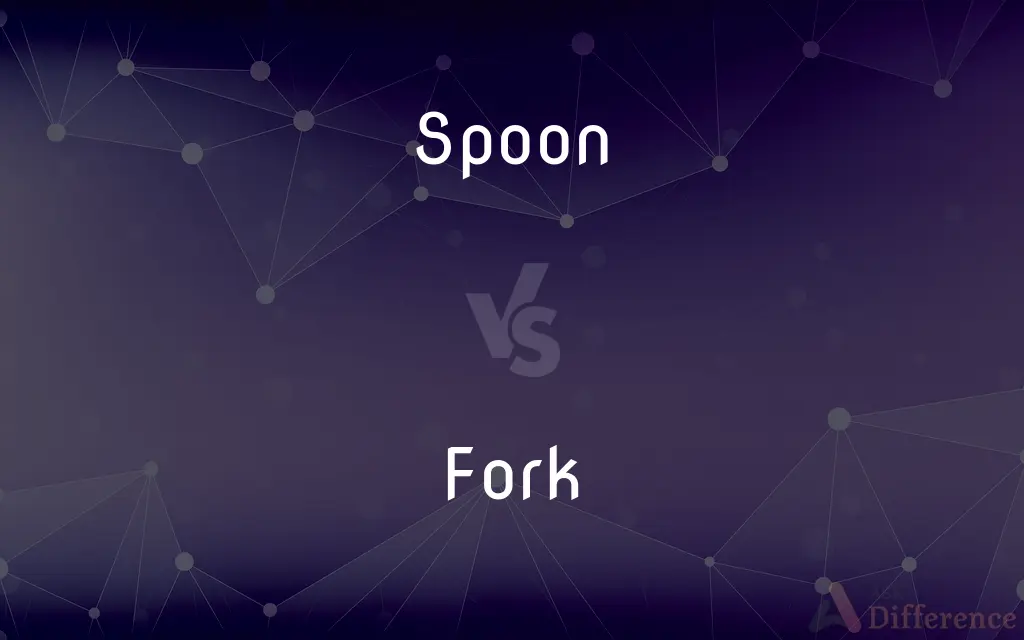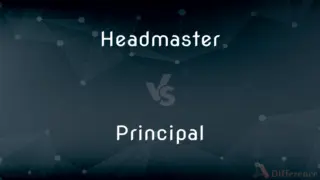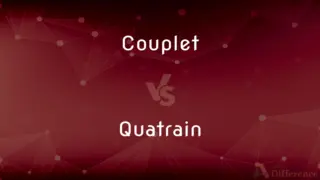Spoon vs. Fork — What's the Difference?
By Tayyaba Rehman & Maham Liaqat — Updated on March 26, 2024
A spoon features a bowl-shaped end for scooping liquids and soft foods, whereas a fork has prongs for picking up and holding solid foods.

Difference Between Spoon and Fork
Table of Contents
ADVERTISEMENT
Key Differences
A spoon is designed with a deep, bowl-like end, making it ideal for consuming liquids and soft foods such as soup and ice cream. On the other hand, a fork is characterized by its thin tines, which are perfect for spearing and lifting solid foods like meats and vegetables.
Spoons come in various sizes and shapes, such as teaspoons and tablespoons, to accommodate different serving needs, while forks are also available in multiple forms, including dinner forks and salad forks, to suit different types of meals.
The material of spoons can range from metal and wood to plastic, depending on their intended use, with metal being common for dining. Forks, similarly, are made from a variety of materials but metal forks are most commonly used in dining settings for their durability and ease of cleaning.
Culturally, spoons are often used in conjunction with forks or chopsticks, depending on the regional dining customs. Forks, however, are a more recent addition to Eastern dining cultures and are predominantly used in Western eating habits.
In terms of etiquette, spoons are generally used with the right hand in cultures that favor utensils, whereas forks can be used in either the left or right hand, depending on whether they are being used alone or with a knife.
ADVERTISEMENT
Comparison Chart
End Shape
Bowl-shaped
Pronged
Primary Use
Scooping liquids and soft foods
Picking up and holding solid foods
Varieties
Teaspoons, tablespoons, soup spoons, etc.
Dinner forks, salad forks, dessert forks, etc.
Material
Metal, wood, plastic
Metal, wood, plastic
Cultural Usage
Universal with variations in size and shape
More common in Western cultures
Dining Etiquette
Used with right hand; varies by culture
Used in either hand, often with a knife
Compare with Definitions
Spoon
Often made of metal, wood, or plastic.
She preferred the wooden spoon for cooking.
Fork
A utensil with several prongs used for eating or serving.
He used a fork to eat his salad.
Spoon
Comes in various sizes for different purposes.
He chose a teaspoon over a tablespoon for his coffee.
Fork
Varies in size for different foods.
Dessert forks are smaller than dinner forks.
Spoon
A utensil with a shallow bowl at one end for eating or serving liquid and semi-liquid foods.
She used a spoon to eat her soup.
Fork
Made from materials like metal or plastic.
The picnic set included plastic forks.
Spoon
Used for measuring ingredients.
Add two spoons of sugar to the recipe.
Fork
Often paired with a knife in Western dining.
The table was set with a fork to the left of the plate.
Spoon
Can be decorative or functional.
The decorative spoon collection was displayed in the cabinet.
Fork
Can be used for cooking or dining.
She used a long fork for grilling.
Spoon
A spoon is a utensil consisting of a small shallow bowl (also known as a head), oval or round, at the end of a handle. A type of cutlery (sometimes called flatware in the United States), especially as part of a place setting, it is used primarily for transferring food to the mouth.
Fork
In cutlery or kitchenware, a fork (from Latin: furca 'pitchfork') is a utensil, now usually made of metal, whose long handle terminates in a head that branches into several narrow and often slightly curved tines with which one can spear foods either to hold them to cut with a knife or to lift them to the mouth.
Spoon
A utensil consisting of a small, shallow bowl on a handle, used in preparing, serving, or eating food.
Fork
A utensil with two or more prongs, used for eating or serving food.
Spoon
A shiny, curved, metallic fishing lure.
Fork
An implement with two or more prongs used for raising, carrying, piercing, or digging.
Spoon
A paddle or an oar with a curved blade.
Fork
A bifurcation or separation into two or more branches or parts.
Spoon
(Sports) A three wood golf club.
Fork
The point at which such a bifurcation or separation occurs
A fork in a road.
Spoon
To lift, scoop up, or carry with or as if with a spoon.
Fork
One of the branches of such a bifurcation or separation
The right fork.
Spoon
Sports & Games To shove or scoop (a ball) into the air.
Fork
(Games) An attack by one chess piece on two pieces at the same time.
Spoon
(Informal) To lie down behind and against (another person) so that both bodies face the same direction with the knees drawn up slightly like nested spoons.
Fork
To raise, carry, pitch, or pierce with a fork.
Spoon
To fish with a spoon lure.
Fork
To give the shape of a fork to (one's fingers, for example).
Spoon
Sports & Games To give a ball an upward scoop.
Fork
(Games) To launch an attack on (two chess pieces).
Spoon
(Informal) To lie down with another person so that both bodies face the same direction with the knees drawn up slightly like spoons nested in each other.
Fork
(Informal) To pay. Used with over, out, or up
Forked over $80 for front-row seats.
Forked up the money owed.
Spoon
(Informal) To engage in amorous behavior, such as kissing or caressing.
Fork
To divide into two or more branches
The river forks here.
Spoon
An implement for eating or serving; a scooped utensil whose long handle is straight, in contrast to a ladle.
Fork
To use a fork, as in working.
Spoon
An implement for stirring food while being prepared; a wooden spoon.
Fork
To turn at or travel along a fork.
Spoon
A measure that will fit into a spoon; a spoonful.
Fork
Any of several types of pronged (tined) tools (physical tools), as follows:
Spoon
A wooden-headed golf club with moderate loft, similar to the modern three wood.
Fork
A utensil with spikes used to put solid food into the mouth, or to hold food down while cutting.
Spoon
(slang) An oar.
Fork
Any of several types of pronged tools for use on farms, in fields, or in the garden or lawn, such as a smaller hand fork for weeding or a larger one for turning over the soil.
Spoon
(fishing) A type of metal lure resembling the concave head of a tablespoon.
Fork
A tuning fork.
Spoon
A spoon excavator.
Fork
(by abstraction, from the tool shape) A fork in the road, as follows:
Spoon
A simpleton, a spooney.
Fork
(physical) An intersection in a road or path where one road is split into two.
Spoon
A safety handle on a hand grenade, a trigger.
Fork
(figurative) A fork.
Spoon
(slang) A metaphoric unit of finite physical and mental energy available for daily activities, especially in the context of living with chronic illness or disability.
Fork
(by abstraction, from the tool shape) A point where a waterway, such as a river or other stream, splits and flows into two (or more) different directions.
Spoon
To serve using a spoon; to transfer (something) with a spoon.
Sarah spooned some apple sauce onto her plate.
Fork
One of the parts into which anything is furcated or divided; a prong; a branch of a stream, a road, etc.; a barbed point, as of an arrow.
A thunderbolt with three forks
This fork of the river dries up during droughts
Spoon
To flirt; to make advances; to court, to interact romantically or amorously.
Fork
A point in time where one has to make a decision between two life paths.
Spoon
To lie nestled front-to-back, following the contours of the bodies, in a manner reminiscent of stacked spoons.
Fork
(metonymically) Either of the (figurative) paths thus taken.
Spoon
To hit (the ball) weakly, pushing it with a lifting motion, instead of striking with an audible knock.
Fork
Process (software development, content management, data management) A departure from having a single source of truth (SSOT), sometimes intentionally but usually unintentionally.
Spoon
(intransitive) To fish with a concave spoon bait.
Fork
(metonymically) Any of the pieces/versions (of software, content, or data sets) thus created.
Single source of truth, SSOT
Spoon
(transitive) To catch by fishing with a concave spoon bait.
Fork
(software) The launch of one or more separate software development efforts based upon a modified copy of an existing project, especially in free and open-source software.
Spoon
Alternative form of spoom
Fork
The splitting of the coverage of a topic (within a corpus of content) into two or more pieces.
A content fork may be intentional (as from a schism about goals) or unintentional (merely from a lack of reorganizing, so far).
Spoon
See Spoom.
We might have spooned before the wind as well as they.
Fork
(cryptocurrency) A split in a blockchain resulting from protocol disagreements, or a branch of the blockchain resulting from such a split.
Spoon
To take up in, or as in, a spoon.
Fork
(chess) The simultaneous attack of two adversary pieces with one single attacking piece (especially a knight).
Spoon
To catch by fishing with a spoon bait.
He had with him all the tackle necessary for spooning pike.
Fork
The crotch. en
Spoon
In croquet, golf, etc., to push or shove (a ball) with a lifting motion, instead of striking with an audible knock.
Fork
(colloquial) A forklift.
Are you qualified to drive a fork?
Spoon
To act with demonstrative or foolish fondness, as one in love.
Fork
Either of the blades of a forklift (or, in plural, the set of blades), on which the goods to be raised are loaded.
Get those forks tilted back more or you're gonna lose that pallet!
Spoon
To fish with a spoon bait.
Fork
In a bicycle or motorcycle, the portion of the frameset holding the front wheel, allowing the rider to steer and balance, also called front fork.
The fork can be equipped with a suspension on mountain bikes.
Spoon
In croquet, golf, etc., to spoon a ball.
Fork
Horse tack The upper front brow of a saddle bow, connected in the tree by the two saddle bars to the cantle on the other end.
Spoon
An implement consisting of a small bowl (usually a shallow oval) with a handle, used especially in preparing or eating food.
"Therefore behoveth him a full long spoonThat shall eat with a fiend," thus heard I say.
He must have a long spoon that must eat with the devil.
Fork
(obsolete) A gallows.
Spoon
Anything which resembles a spoon in shape; esp. (Fishing), a spoon bait.
Fork
(mining) The bottom of a sump into which the water of a mine drains.
Spoon
Fig.: A simpleton; a spooney.
Fork
(ambitransitive) To divide into two or more branches or copies.
A road, a tree, or a stream forks.
Spoon
A wooden club with a lofted face.
Fork
To spawn a new child process by duplicating the existing process.
Spoon
A piece of cutlery with a shallow bowl-shaped container and a handle; used to stir or serve or take up food
Fork
To launch a separate software development effort based upon a modified copy of an existing software project, especially in free and open-source software.
Spoon
As much as a spoon will hold;
He added two spoons of sugar
Fork
To create a copy of a distributed version control repository.
Spoon
Formerly a golfing wood with an elevated face
Fork
(transitive) To move with a fork (as hay or food).
Spoon
Scoop up or take up with a spoon;
Spoon the sauce over the roast
Fork
To kick someone in the crotch.
Spoon
Snuggle and lie in a position where one person faces the back of the others
Fork
(intransitive) To shoot into blades, as corn does.
Fork
(transitive) fuck
Fork
To bale a shaft dry.
Fork
An instrument consisting of a handle with a shank terminating in two or more prongs or tines, which are usually of metal, parallel and slightly curved; - used for piercing, holding, taking up, or pitching anything.
Fork
Anything furcate or like a fork in shape, or furcate at the extremity; as, a tuning fork.
Fork
One of the parts into which anything is furcated or divided; a prong; a branch of a stream, a road, etc.; a barbed point, as of an arrow.
Let it fall . . . though the fork invadeThe region of my heart.
A thunderbolt with three forks.
Fork
The place where a division or a union occurs; the angle or opening between two branches or limbs; as, the fork of a river, a tree, or a road.
Fork
The gibbet.
Fork
To shoot into blades, as corn.
The corn beginneth to fork.
Fork
To divide into two or more branches; as, a road, a tree, or a stream forks.
Fork
To raise, or pitch with a fork, as hay; to dig or turn over with a fork, as the soil.
Forking the sheaves on the high-laden cart.
Fork
Cutlery used for serving and eating food
Fork
The act of branching out or dividing into branches
Fork
A part of a forked or branching shape;
He broke off one of the branches
They took the south fork
Fork
An agricultural tool used for lifting or digging; has a handle and metal prongs
Fork
The angle formed by the inner sides of the legs where they join the human trunk
Fork
Lift with a pitchfork;
Pitchfork hay
Fork
Place under attack with one's own pieces, of two enemy pieces
Fork
Divide into two or more branches so as to form a fork;
The road forks
Fork
Shape like a fork;
She forked her fingers
Common Curiosities
Are spoons used worldwide?
Yes, spoons are used globally, with variations in form depending on the culture.
What distinguishes a fork from a spoon?
A fork has prongs for spearing foods, unlike the bowl-shaped end of a spoon.
What is the main purpose of a spoon?
To scoop and eat liquids and soft foods.
Can forks be made of wood?
Yes, though metal is more common, forks can also be made of wood.
Do all cultures use forks?
Forks are predominantly used in Western cultures, with varying acceptance elsewhere.
Is it proper to eat soup with a fork?
Generally, soup is eaten with a spoon due to its liquid nature.
Why do forks have different numbers of tines?
The number of tines can vary based on the fork's intended use, such as dining or serving.
What is a salad fork?
A salad fork is smaller than a dinner fork, designed for eating salads.
Are there spoons designed specifically for desserts?
Yes, dessert spoons are smaller than regular spoons for sweets and desserts.
What material is best for dining utensils?
Metal is commonly preferred for its durability and ease of cleaning.
Can you use a spoon for salad?
It's uncommon; salads are typically eaten with a fork.
Can you measure ingredients with a fork?
While possible, spoons are typically used for measuring due to their shape.
Is there a difference in etiquette for using spoons and forks?
Yes, etiquette varies by culture, including which hand to use and how to position them on the table.
Is it common to find forks in traditional Asian dining?
Forks are less common in traditional Asian dining, where chopsticks or spoons are preferred.
Why might someone use a plastic fork?
Plastic forks are convenient for picnics or where washing dishes is not feasible.
Share Your Discovery

Previous Comparison
Headmaster vs. Principal
Next Comparison
Couplet vs. QuatrainAuthor Spotlight
Written by
Tayyaba RehmanTayyaba Rehman is a distinguished writer, currently serving as a primary contributor to askdifference.com. As a researcher in semantics and etymology, Tayyaba's passion for the complexity of languages and their distinctions has found a perfect home on the platform. Tayyaba delves into the intricacies of language, distinguishing between commonly confused words and phrases, thereby providing clarity for readers worldwide.
Co-written by
Maham Liaqat















































